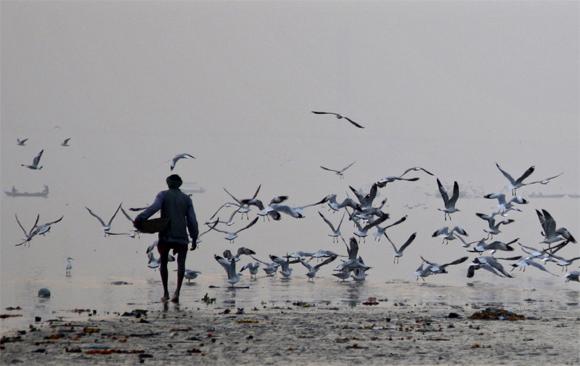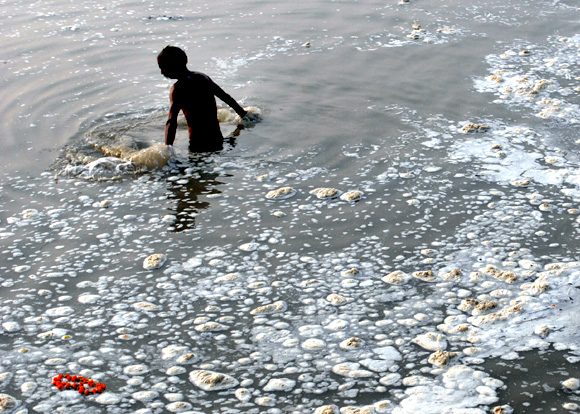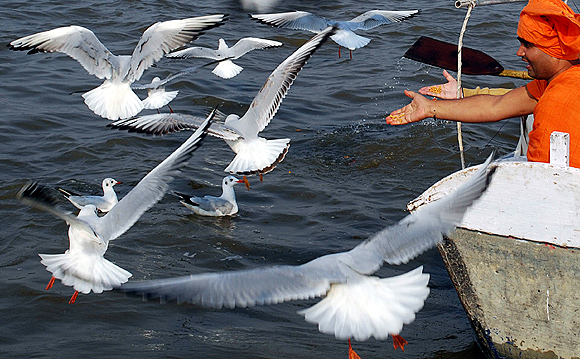 | « Back to article | Print this article |
Saving Ganga: Time is not on our side, says PM Singh
Speaking at the third meeting of the National Ganga River Basin Authority on Tuesday, Prime Minister Manmohan Singh voiced concern over the discharge of 2,900 million litres of sewage in the Ganga every day. The prime minister asked state governments to send proposals for new sewage treatment plants and said that adequate funding was available to take up projects.
Read the prime minister's full speech.
I am happy to be present here today at the third meeting of the National Ganga River Basin Authority. I extend a very warm welcome to you all.
The National Ganga River Basin Authority was set up as a high level body that would give focused attention to fulfilling our sacred and solemn duty to restore the pristine glory of the Ganga and preserve its riches for future generations. The Centre, the Ganga basin states, civil society and industry should work together to make a success of this important national endeavour.
Click NEXT to read further...
We have to act quickly
We should remember that our efforts in the past have not been very successful. Therefore, we must together show a renewed and sincere commitment in both thought and action to make a definite change in the situation.
We must find the right balance between the need for environmental and ecological conservation of the Ganga and its basin on the one hand and the imperatives of growth and development on the other.
I commit the Government of India to work purposefully in this direction as a top priority.
Friends,
Increasing urbanisation, industrialisation and population are not only polluting the Ganga waters, but also threatening its ecological and hydrological viability. Added to this are the specter of climate change and melting of glaciers that are also likely to affect the flows of the river adversely.
The task before us is therefore a highly complex one. We will have to pool our intellectual and physical resources in a coordinated and coherent manner if we are to rise to this challenge.
Time is not on our side and we have to act quickly. At the same time, whatever we do should not be piecemeal, should meet the test of scientific reasoning and be a rational and practical approach that addresses the views and concerns of all stakeholders.
In order to formulate long term policies and actions, the Ministry of Environment and Forests commissioned a consortium of seven IITs to prepare a comprehensive River Basin Management Plan for the Ganga. This Plan would recommend comprehensive measures to restore and maintain the ecological health of the river giving due regard to the competing water uses and the necessity of a paradigm shift in the manner in which we exploit land, water and other natural resources in the Ganga basin.
Click NEXT to read further...
Performance of the states has been tardy
This plan will be the basis for the NGRBAs long term action plan to deal with the multiple challenges we face in the task of cleaning the Ganga and maintaining its flows. The consortium has already submitted five initial reports. I urge them to carry on their work expeditiously and with due diligence.
While we await this comprehensive study and plan of action, we should take certain urgent measures that are required anyway or which would be difficult to take later on.
First is on the issue of untreated sewage. Every day about 2,900 million litres of sewage is discharged into the main stream of the river Ganga from municipal towns located along its banks. The existing infrastructure has a capacity to treat only 1,100 million litres per day, leaving a huge deficit.
There is adequate funding available to create additional treatment facilities under the National Mission Clean Ganga. I would urge the states to send appropriate proposals for new projects.
The performance of the states with regard to the operation and maintenance of the existing sewage treatment plants has been tardy. There is under-utilisation of this infrastructure, particularly in the absence of connecting sewerage networks such as branch sewers and house sewer connections. The Central government is examining some easing of the funding norms for O&M works.
The second issue is with regard to industrial pollution. Though they are only 20 per cent of the total volume of effluents, industrial effluents are a cause for major concern because they are toxic and non-biodegradable.
Most of the waste water comes from tanneries, distilleries, paper mills and sugar mills along the banks of the Ganga. The state pollution control boards are required to monitor compliance of effluent discharge standards by such industries.
Action must be taken against the defaulting industries by the state boards under the powers delegated to them by the Central government. I would request the State governments to strengthen the relevant enforcement mechanisms.
I would request the chief ministers to make an assessment of the situation with regard to both untreated sewage and industrial pollution and present a report to the NRGBA on the situation in their respective states. We can then decide what concrete steps are necessary to attend to some of the institutional, administrative and financial problems that may be coming in the way of more effective implementation of pollution control and abatement measures.
Click NEXT to read further...
Make full use of resources available with NRGBA
Many of the things that we could do are self evident and do not require detailed scientific studies. States should earmark adequate resources and give priority to capacity building of urban local bodies.
I urge all the concerned state governments to make full use of the resources that are available with the NRGBA.
Projects with an outlay of more than Rs 2,600 crore have been sanctioned so far under the NGRBA in the states of Uttar Pradesh, Uttarakhand, Bihar and West Bengal for creating sewer networks, sewage treatment plants, sewage pumping stations, electric crematoria, community toilets and development of river fronts.
A third area that warrants immediate action and attention is the need to maintain the ecological flow of the Ganga, starting with the upper reaches of the river. This must necessarily involve a number of steps. State governments and urban local bodies should promote water conservation and recycling of treated waste water. There is a need to promote efficient irrigation practices as a large amount of water from the Ganga is drawn through the canal systems in the upper reaches for agricultural use. There is also the complex problem of tackling water use by hydel projects in the upper reaches.
The government of India had commissioned a study conducted by IIT Roorkee on the assessment of cumulative impact of hydropower projects in Alaknanda and Bhagirathi basins up to Devprayag. Separately, the Wildlife Institute of India had also made an assessment of cumulative impact of hydroelectric projects on aquatic and terrestrial biodiversity in the Alaknanda and Bhagirathi basins in Uttarakhand.
These studies had worked out certain desirable ecological flows. The IIT Roorkee report stated that the environmental flow requirement or EFR depends on the stage of development of the area and the societal requirement. The same report recommended that exact values of EFR for every single project for implementation should be established after carrying out detailed measurements of discharge, river cross sections and assessment of impact on biotic life as a result of reduced discharge on commissioned hydropower projects and consultation with the local community.
The issue of environmental flow requirement as studied and recommended by the IIT Roorkee Committee as well as the minimum flow required to sustain riverine ecology recommended by the Wildlife Institute of India, should be examined by a multi-disciplinary group, including the concerned State Governments. The group should look holistically at the various options available and recommend broad principles and actions that need to be taken with regard to conservation, irrigation use and running of hydel projects that will ensure uninterrupted flow of the river Ganga. Based on the recommendations of the group, we will draw up and implement a road map for further actions that we need to take.
We should use the IIT Roorkee and Wildlife institute of India studies to guide what actions we need to take pending formulation of a long term policy.
I look forward to a constructive and purposeful discussion. Thank you.
TOP photo features of the week
Click on MORE to see another set of PHOTO features...




